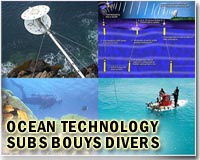| . |  |
. |
Boston, Massachusetts (AFP) March 21, 2011 Seafood industry players from around the world grappled here Monday with ways to net the most elusive catch of all: a solution to the problem of feeding growing appetites with ever fewer fish. The annual International Boston Seafood Show gathered nearly 900 exhibitors from 130 countries including restaurant buyers and hotels, wholesalers, processors and brokers. With demand surging, they have the luxury of working in a booming market. The United States imports 83 percent of its seafood and the government's publication of new anti-obesity dietary recommendations, including a doubling fish consumption, points toward Americans needing a lot more. Currently, average seafood consumption the United States reaches only seven kilos (15.4 pounds) a year per person, against 50 kilos (110 pounds) for beef and 35 kilos (77 pounds) for poultry, said Gavin Gibbons, spokesman for the National Fisheries Institute. "The Japanese consume five to six times as much seafood as we do," Gibbons said. "Doctors and dietitans suggest that Americans should double their consumption and the US secretary of agriculture has recently said that Americans should begin to replace some of their meals with seafood." The question for those catching, selling and serving the fish, though, is how to make sure that the world's already over-fished seas can actually provide what is needed. At the start of the three-day Boston trade fair attended by 20,000 people, six industry members were honored for their efforts at promoting sustainability in the supply chain. One of them was French restaurant entrepreneur Olivier Roellinger, vice chairman of the Relais et Chateaux chain, which was singled out for work within the industry to highlight risks facing the environment. "Olivier invited 400 chefs of Relais et Chateaux to (fisheries in) Norway to help them understand sustainability," said Jonathan Cartwright, chef at the White Barn Inn in Kennebunkport, Maine, who was accepting the prize on behalf of Roellinger. The threats to bringing seafood to the world's menus go beyond the ravages of over-fishing. Asia, where seafood is already a staple, is seeing environmental destruction on Thailand's coasts, and a fall in shellfish and big fish populations that echo earlier catastrophes in US and European waters. "When I saw seafood decline in Maryland..., I went to Asia, where I have 17 factories. Then I saw the decline there too, five or six years ago, so I decided to form an association and to draw producers to sustainability," said Steve Phillips, CEO of Phillips Food and Seafood Restaurants Baltimore. "The most important is getting governments to impose rules and regulations. The minimum size of the crab must be eight-10 cm (three-four inches). The challenge is the enforcement. We need the governments to do that," Phillips said. Many at the trade fair feel that farming is the only way out. Farmed seafood already accounts for 50 percent of supplies. Environmentalists say the practice causes its own problems including the introduction of diseases and the need to harvest huge amounts of wild fish in order to feed those held in pens. Supporters, however, say there are positive trends including fish that turn vegetarian such as the barramundi, a carnivore that can live on a largely vegetarian diet and as a result is seen by some as a champion of the "green" menu. The next frontier could be genetically modified fish, with companies like Aquabounty waiting for US regulatory approval on its modified salmon which can grow twice as fast as a natural salmon.
Share This Article With Planet Earth
Related Links Water News - Science, Technology and Politics
 World learns from Dutch to keep head above water
World learns from Dutch to keep head above waterRotterdam, Netherlands (AFP) March 21, 2011 Dubai's Palm Island, New Orleans' upgraded dykes and Australia's water recycling plants all have one thing in common: they benefited from Dutch know-how gained in the country's age-old quest for dry feet. "The Netherlands has always battled against this natural enemy - water," said Hanneke Heeres of the Union of District Water Boards (UvW), which after 900 years existence is the Netherlan ... read more |
|
| The content herein, unless otherwise known to be public domain, are Copyright 1995-2010 - SpaceDaily. AFP and UPI Wire Stories are copyright Agence France-Presse and United Press International. ESA Portal Reports are copyright European Space Agency. All NASA sourced material is public domain. Additional copyrights may apply in whole or part to other bona fide parties. Advertising does not imply endorsement,agreement or approval of any opinions, statements or information provided by SpaceDaily on any Web page published or hosted by SpaceDaily. Privacy Statement |